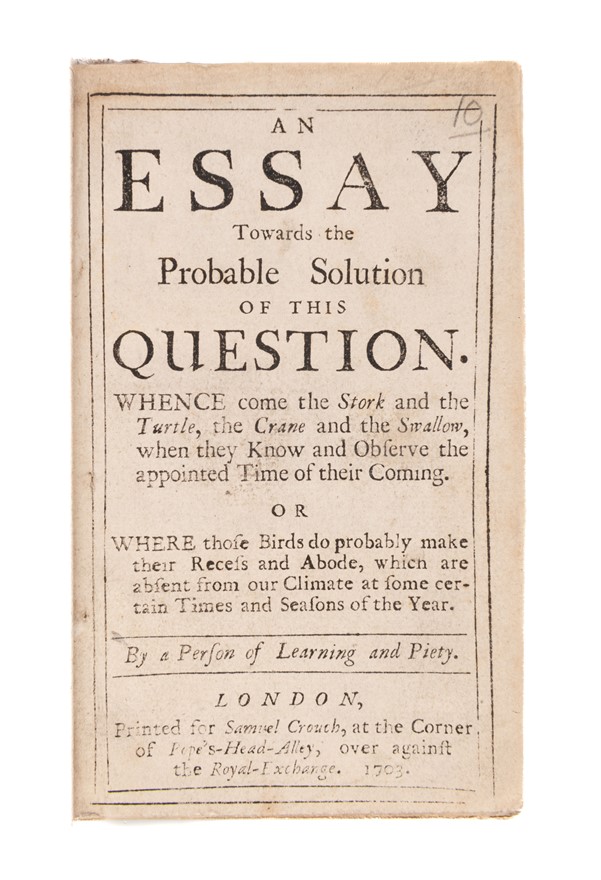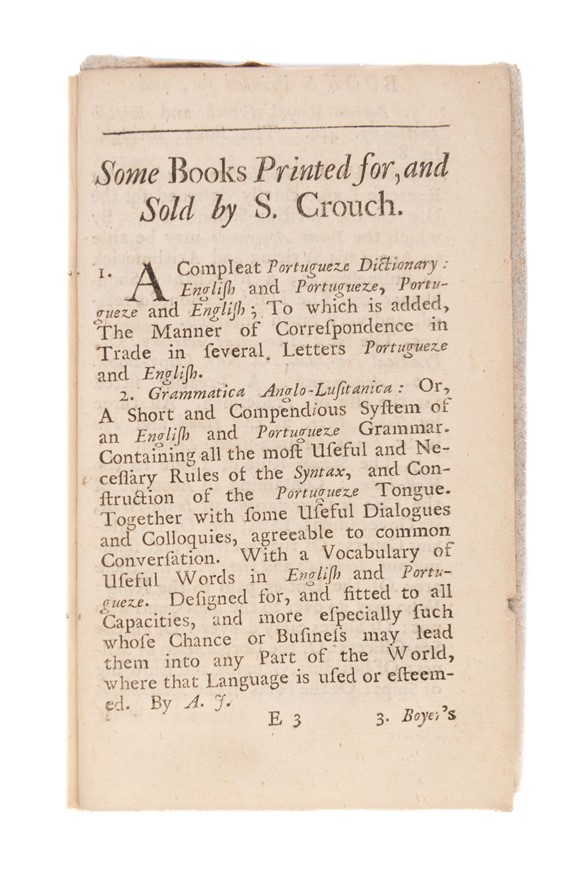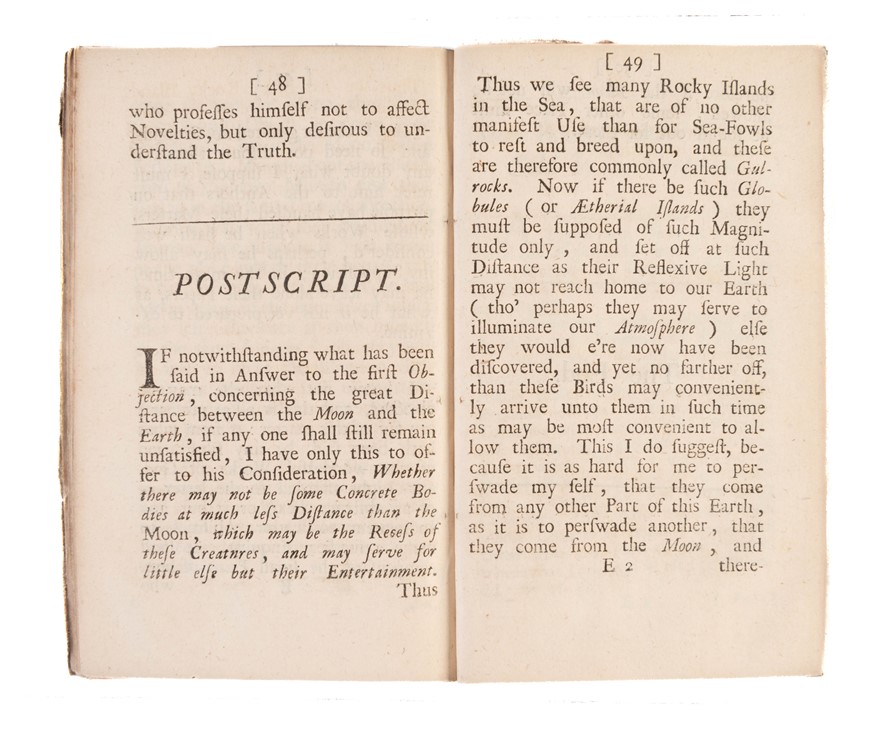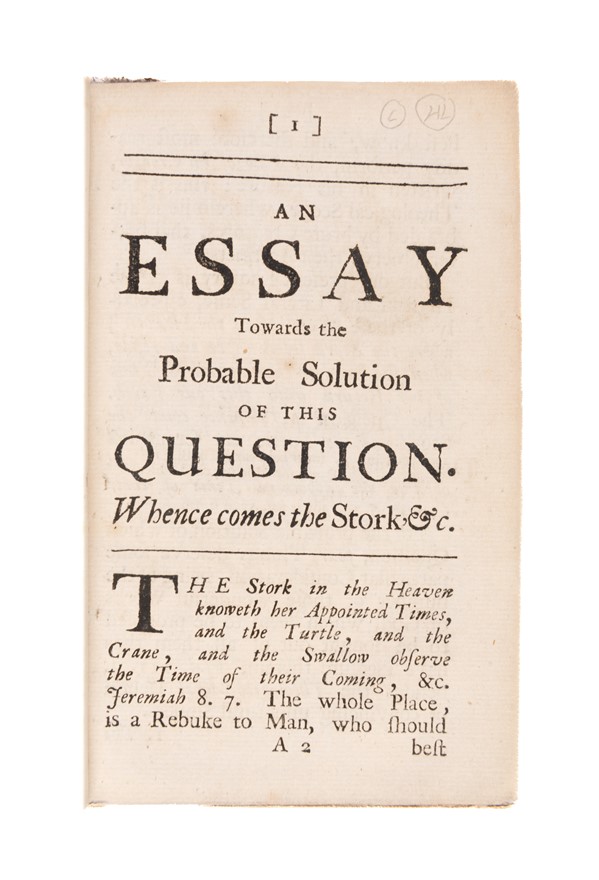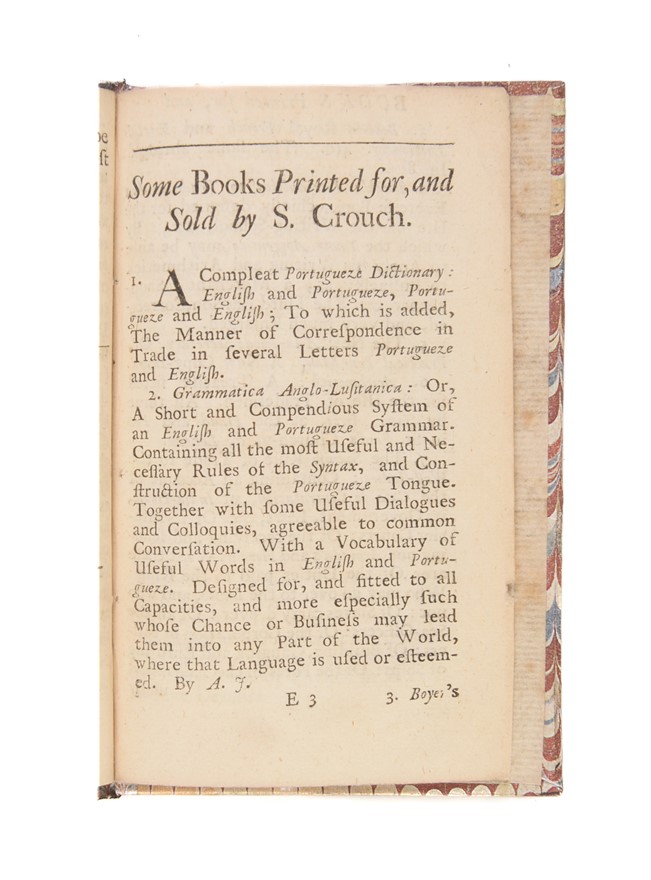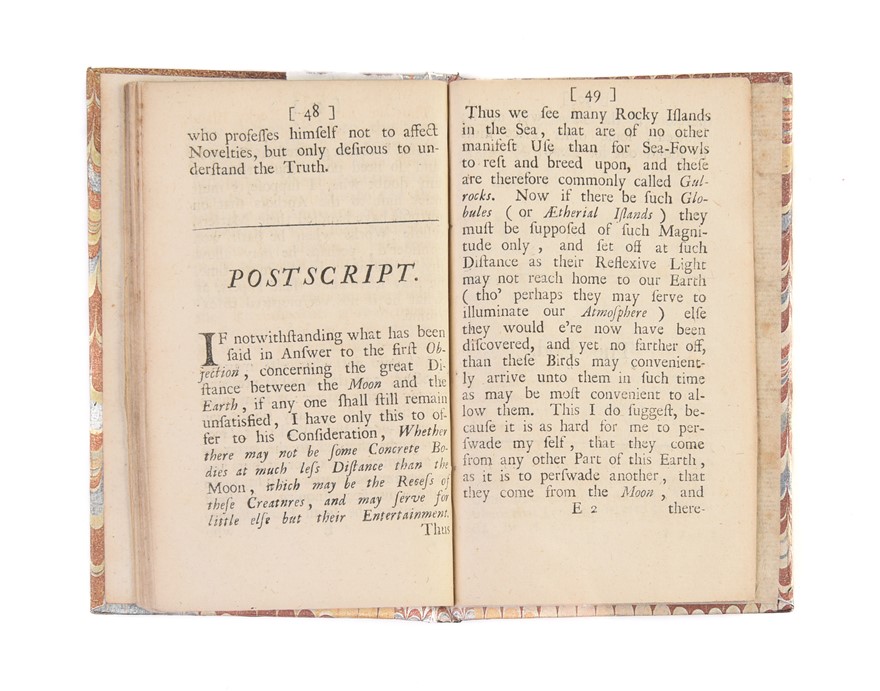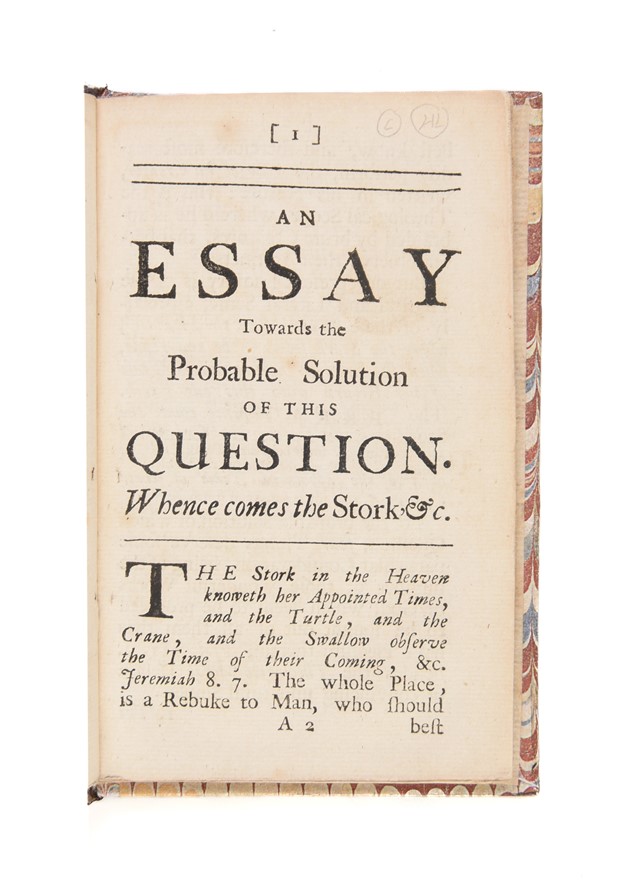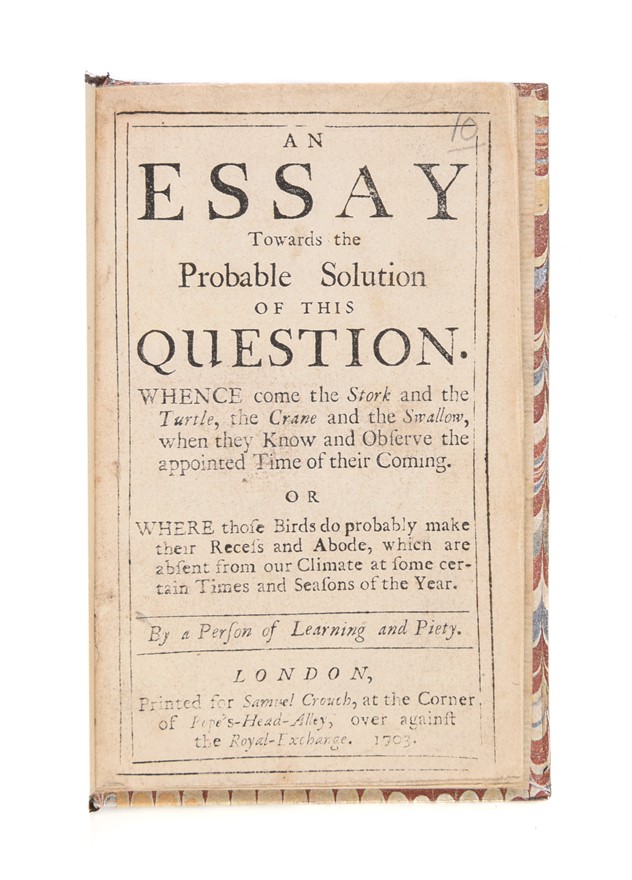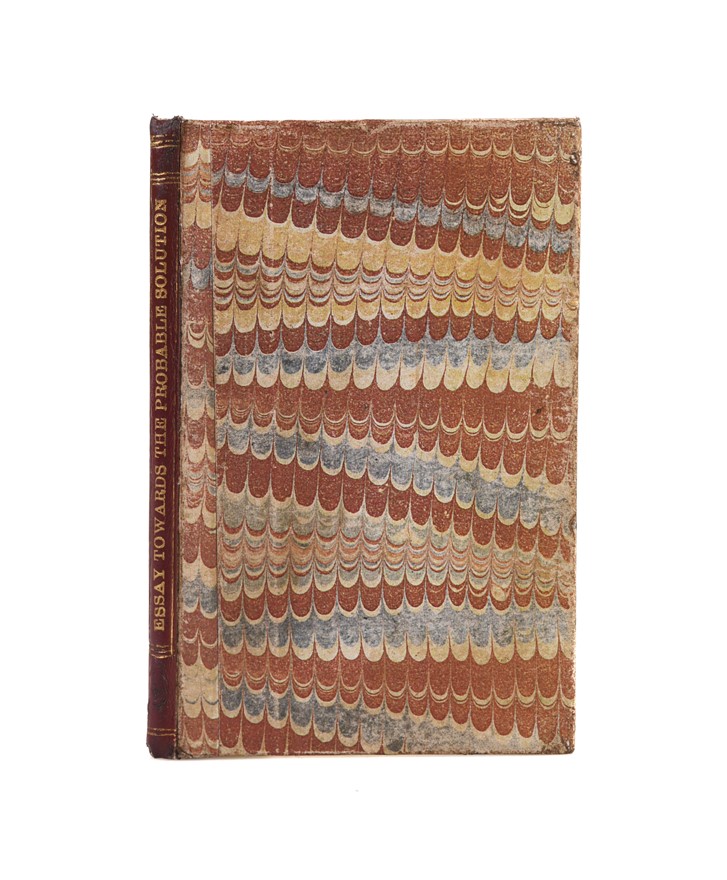An Essay towards the Probable Solution of this Question. Whence come the Stork and the Turtle, the Crane and the Swallow,
MORTON Charles (1703)
£3000.00 [First Edition]
Please contact us in advance if you would like to view this book at our Curzon Street shop.
"PROBABLY THE MOST REMARKABLE THEORY THAT HAS BEEN ADVANCED TO ACCOUNT FOR MIGRATION"
when they know and observe the appointed time of their coming. Or where those birds probably make their recess and abode, which are absent from our climate at some certain times and seasons of the year.
First Edition. 12mo (147 x 99mm). [2], 50, [4]pp., with the two final advertisement leaves. Title-page a little dusty, a little browned in places but otherwise fine. Modern marbled boards, red leather spine label.
London: for Samuel Crouch,
ESTC records five locations in the US - Folger (x2, 1 copy is lacking three leaves), Harvard ("imperfect...small hole in title-page affecting text"), Huntington, William Andrews Clark and Yale. No copies recorded on Rare Book Hub or ABPC. A "second edition" was published in 1739 (BL and Glasgow (Hunterian) only). Some copies have a small errata slip pasted on the blank verso of the title-page, it is not present here and the errata is not corrected.
"The earliest treatise on bird migration in England" suggesting that migrating birds fly to the moon for winter. With reference to Copernicus, Galileo, and Kepler.
"The seventeenth century was completely engrossed with the physical and astronomical problems of human flight to the moon and, in biology with questions of classification and structure. Charles Morton stands alone in attempting to solve the age-old problem of bird migration, which was more intensely to occupy later students.
Regarded today as a fantastic curiosity, in its proper setting in the seventeenth century, this serious study vividly reflects the new and prodigious interest in the heavens following Copernicus, Galileo, and Kepler" (Thomas P. Harrison, Birds in the Moon, Isis, December 1954, p.323)
This little work by the nonconformist minister and tutor Charles Morton (bap. 1627, d.1698) was published posthumously and argues that, "it is not impossible that divers of these fowls, which make such changes, and observe the seasons, do pass and repass between this and the Moon" (p.18). Morton takes for his starting point the passage from Jeremiah: "The Stork in the Heaven knoweth her Appointed Times, and the Turtle, and the Crane, and the Swallow observe the Time of their Coming..." but opens out the argument from birds commonly found in the Holy Lands to take in a multitude of different birds, insects, fish and mammals. Morton also moves away from theological matters and places his inquiry into the seventeenth century desire to understand the solar system and flight:
"The seventeenth century was completely engrossed with the physical and astronomical problems of human flight to the moon and, in biology with questions of classification and structure. Charles Morton stands alone in attempting to solve the age-old problem of bird migration, which was more intensely to occupy later students"
"I do suppose, that the Hypothesis of Copernicus is Reasonable, and may be Real, without any contradiction to Scripture, namely, That the Moon's Body (as also of the other Five Planets) is of a Composition like our Earth, and may have in it dry Land and Water, Mountains and Valleys, Fountains, Streams, Seas, &c. and about it an Atmosphere of Vapours and Fumes from its Body, Clouds, Rain, &c like the Earth we inhabit, and by consequence convenient Entertainment for those Fowls in case they arrive thither" (p.17-8).
Morton concludes that as no one has ever located a migratory bird on earth during their period of migration it seems likely that they must remove themselves entirely from the planet and travel to the moon. Morton even suggests that he has noticed that, "their chearfulness seems to imitate, that they have some noble design in hand, and some great attempt to set presently upon, namely to get above the atmosphere, high, and flie away to the other world" (p.29).
Morton was born in Cornwall (he mentions in the text information concerning the woodcock that he has received from "the Reverend Mr. Thomas Travers of Cornwall, who received it from the Captain or Master of the Vessel"). He initially entered Cambridge but moved to Oxford, "as part of an influx of Cambridge men into the older university after it was purged of royalists by the parliamentary visitors" (ODNB). Morton returned to Cornwall but was soon in London where he taught at the Dissenting academy in Newington Green. He was later forced into exile in America and arrived in Boston in June 1686.
Morton taught at Harvard (he had expected to be given the presidency) and was installed as pastor at Charlestown, Massachusetts. "In 1692 he joined in signing an advice to the judges in the Salem witchcraft trials, cautioning against the admission of spectral evidence" (ODNB). Morton died at Charlestown in April 1698.
His significance was as a teacher who through his compendia and instruction disseminated new ideas in philosophy and natural science in both England and New England...he recognized the importance of observation and measurement and of such new instruments as the telescope and microscope, and was a proponent of experimental method (ODNB)..
Stock Code: 246163
